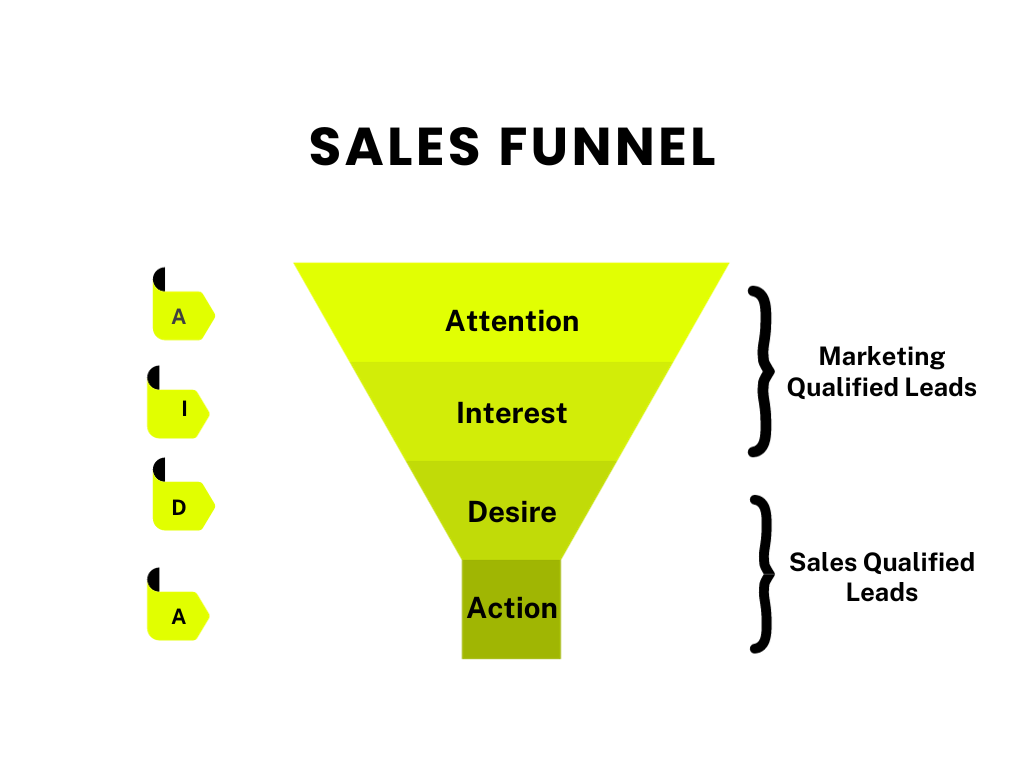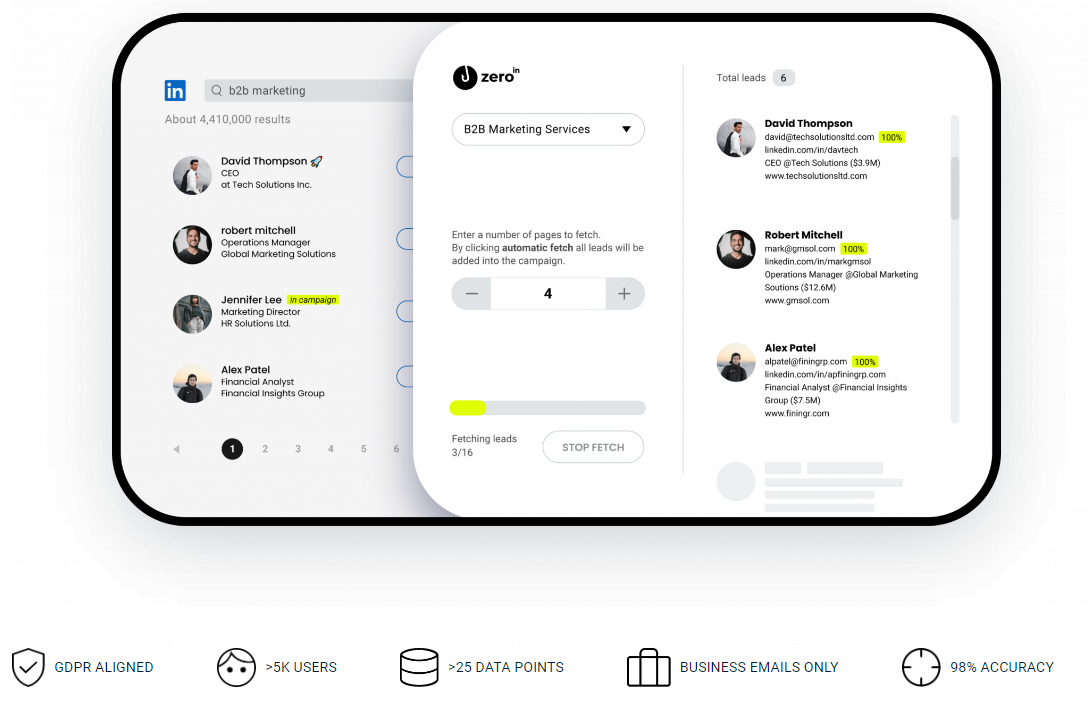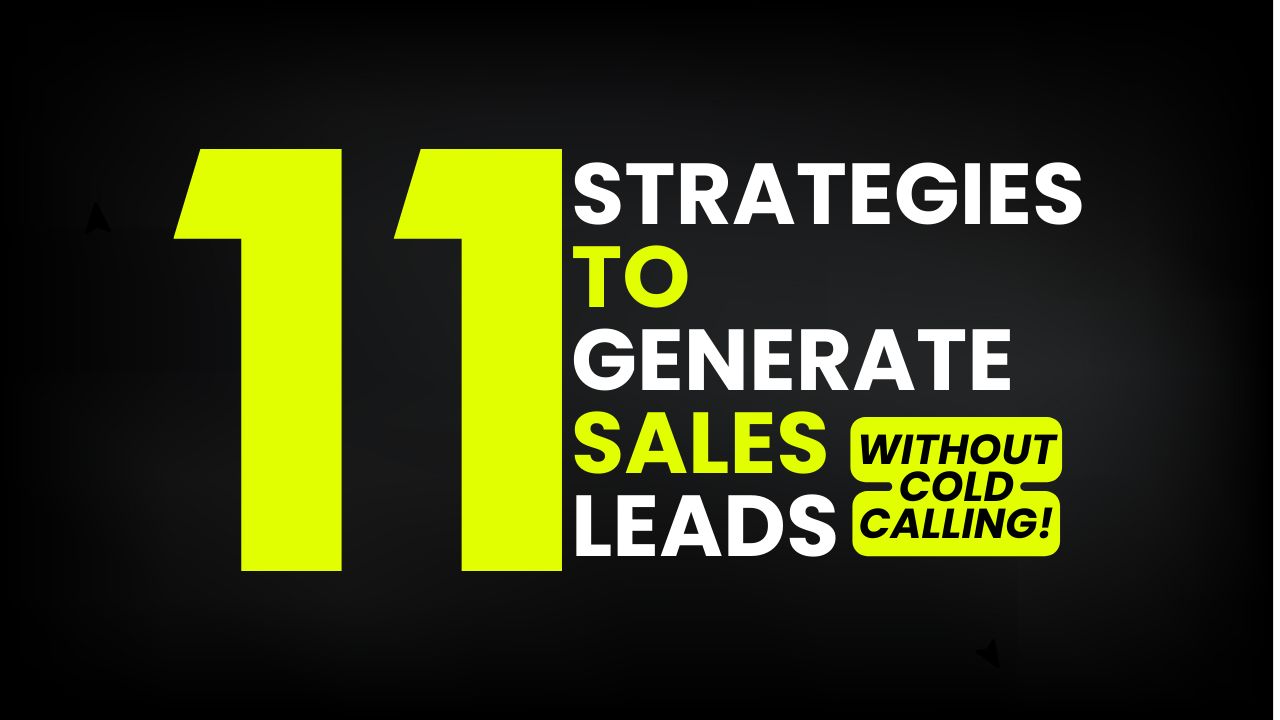Let’s face it: cold calling has its place.
Surprisingly, 27% of sales teams still swear by the phone as their top tool for booking meetings.
Even more intriguing, 17% of B2B marketers rely on cold calling as their primary customer acquisition channel.
It’s clear – this method has clout, especially considering that 57% of high-level decision-makers across various industries prefer phone calls over other forms of communication.
Yet, here’s the rub: if cold calling is your sole strategy for lead generation, you’re not just walking on a tightrope, you’re potentially missing out on a broader landscape of opportunities.
While cold calls have their merit, the savvy salesperson knows the importance of diversifying their lead generation toolkit.
Summary
In this blog guide, we’ll delve into 11 innovative strategies that go beyond cold calling, providing you with a robust arsenal for generating sales leads.
Each tactic has been carefully chosen for its effectiveness and practicality in today’s sales landscape.
From leveraging the power of content marketing to mastering the nuances of social media engagement, these strategies are designed to enhance your lead-generation efforts.
They’re straightforward, easy to implement, and most importantly, they align with the evolving preferences of today’s consumers and decision-makers.
By the end of this blog, you’ll have a clear roadmap for diversifying your lead generation approach, equipping you to capture more leads, engage more prospects, and ultimately, close more deals.
What is considered a Qualified Lead?
A qualified lead is essentially a potential customer who not only fits the mold of your ideal buyer but has also shown a genuine interest in making a purchase.
This type of lead isn’t just a name on a list.
It’s someone who has been carefully vetted by your marketing team, scrutinized by your sales crew and has demonstrated a clear willingness to buy what you’re selling.
In the world of lead generation, you’ll often hear about two types: MQLs (Marketing Qualified Leads) and SQLs (Sales Qualified Leads).

Think of MQLs as those leads who have just started showing some interest. They’re like acquaintances at a party who’ve expressed a liking for the same things as you but aren’t quite friends yet.
On the other hand, SQLs are like friends who you know are interested and ready for deeper engagement. They’re the ones who have moved beyond just showing interest and are seriously considering a purchase.
When businesses talk about ‘qualified leads’, they’re mostly referring to these SQLs – the leads that truly stand out and are ready for the next step in the sales process.
Can you generate sales leads without cold calling?
At first glance, this question seems almost too obvious to ask. But after giving it some thought, we realized it’s a crucial point to address.
The belief that cold calling is the primary, if not the only, way to generate leads is still deeply ingrained in many businesses.
This is evident from the statistics that highlight its widespread use.
However, the real question isn’t whether it’s possible to generate leads without cold calling.
Instead, it’s whether you can generate enough quality leads to sustain and grow your business without solely relying on this method.
The answer? It depends.
Some businesses, particularly those whose sales and marketing strategy has been deeply anchored in cold calling, might find it challenging to suddenly switch gears and adopt an entirely new approach.
If cold calling has been your bread and butter for getting clients, and you suddenly stop without a solid alternative strategy in place, you’re likely to see a dip in the results.
However, this doesn’t mean that other marketing and sales strategies aren’t effective.
It simply means that transitioning to a new method of generic prospects and clients requires a strategic approach.
You need to carefully integrate new tactics into your existing sales and marketing process, ensuring they complement rather than completely replace cold calling, at least initially.
The goal is to gradually build a diverse lead generation portfolio that doesn’t solely rely on any single method.
This approach not only broadens your reach but also cushions your business against the volatility of relying on a single lead source.
In the following sections, we will explore various inbound and outbound marketing strategies that can help you achieve this balance, enabling you to generate sufficient leads without being entirely dependent on cold calling.
How to generate cold leads without cold calling?
Now, let’s tackle a pivotal question: How do you reel in those elusive cold leads without resorting to the phone?
It’s about crafting a strategy that’s both effective and adaptable, and one that taps into the diverse channels and tools at your disposal.
In the sections that follow, we’ll dive into a variety of techniques that can help you capture leads.
These strategies are not just alternatives to cold calling; they’re modern, dynamic, and designed to align with the evolving preferences of today’s market.
Let’s explore how you can keep your lead pipeline flowing without dialing a single number.
Strategy #1 Content Marketing
Content marketing is a powerhouse in the world of lead generation, and for good reason.
It’s about sharing valuable information – be it through blog posts, videos, or social media content – that resonates with your audience.

The goal here is to provide insights or solutions that your potential customers are seeking.
By doing this, you’re not just catching their attention; you’re building trust and establishing your brand as an authority in your field.
To give you an idea of its effectiveness, consider these stats:
- Companies that blog consistently generate 67% more leads per month than those that don’t.
- Content marketing costs 62% less than traditional marketing and generates about three times as many leads.
- 70% of people would rather learn about a company through articles rather than an advertisement.
These numbers highlight the undeniable impact of content marketing.
But it’s not just about throwing content out there and hoping for the best.
It’s about a strategic approach that involves:
1. Understanding Your Audience: Know their interests, challenges, and questions. Tailor your content to meet these needs.
2. Consistency: Regularly produce and share content to stay on your audience’s radar.
3. Quality Over Quantity: Focus on creating content that is informative, engaging, relevant and actually useful for people consuming it.
4. Diverse Formats: Utilize various content types like blogs, videos, infographics, and podcasts to cater to different preferences.
5. SEO Optimization: Use relevant keywords and optimize your content for search engines to increase visibility.
In summary, the true power of content marketing in generating prospects lies in its ability to first capture and then hold the audience’s attention.
By consistently providing valuable content, you’re not just filling your website with keywords and information, you’re creating multiple entry points for potential leads.
Each piece of content serves as a magnet, attracting those looking for solutions that you offer.
This strategy effectively turns your online presence into a lead-generating machine, where every article, video, or post has the potential to attract and initiate the customer journey.
More entries = more leads.
Strategy #2 Search Engine Optimization (SEO)
When it comes to generating leads without cold calling, Search Engine Optimization (SEO) stands as a cornerstone strategy.
At its core, SEO is about optimizing your website and content to rank higher on search engine results pages.
The higher you rank, the more likely people are to find you when they’re searching for solutions you offer.
It’s a direct path to getting in front of potential prospectswithout ever needing to make a call.
The impact of SEO is clear in the numbers:
- 93% of online experiences begin with a search engine, highlighting the importance of ranking well.
- Google’s first page captures 71% of search traffic clicks, and this percentage is even higher in some cases. Being on the second page is almost like being invisible.
- 61% of marketers say improving SEO and growing their organic presence is their top inbound marketing priority. This underscores the value businesses place on organic search results.
These statistics underscore the power of being easily discoverable online.
SEO is about tapping into the search habits of your target audience and ensuring your site pops up when they’re looking for what you offer.
Here’s how you can leverage SEO:
1. Keyword Research: Identify the terms and phrases your potential customers are using to find solutions you provide. Incorporate these keywords into your website content, blogs, and articles.
2. On-Page Optimization: Ensure that each page on your website is optimized for search engines, including meta titles, descriptions, and header tags.
3. Quality Content: Search engines favor content that is informative, well-written, and relevant to user queries so produce content that’s not only SEO-friendly but also valuable to your audience. This improves your site’s relevance and authority.
4. Mobile Optimization: With the majority of searches now on mobile devices, a mobile-friendly website is essential.
5. Backlinks: Build backlinks from reputable sites. They act as endorsements, improving your site’s authority and search ranking.
Implementing SEO is not a one-time task but an ongoing process.
Search engines constantly update their algorithms, so keeping your SEO strategies up-to-date is crucial.
By investing in SEO, you’re not only increasing your visibility but also positioning your brand as a credible and authoritative source in your industry, which in turn, helps in generating high-quality prospects who are more likely to convert.
Strategy #3 Social Media Marketing

Social media marketing has rapidly evolved into a vital tool for B2B lead generation.
It’s no longer just about brand awareness or digital presence, it’s a dynamic platform for directly engaging with potential leads.
With billions of users across various platforms, SMM offers a unique opportunity to connect with a vast audience on a personal level.
Take a look at these 2023 statistics to grasp the impact of social media in the B2B space:
- 83% of B2B marketers use social media as a channel for lead generation.
- LinkedIn, known for its professional networking, drives more than 50% of all social traffic to B2B websites and blogs.
- 72% of B2B buyers use social media to research solutions for their business needs.
These figures demonstrate just how integral social media has become in the B2B lead generation process.
Here’s how to make the most of social media marketing:
1. Platform Selection: Choose platforms where your target audience is most active. For B2B, LinkedIn often tops the list, but don’t overlook the potential of others like Twitter or Facebook.
2. Engaging Content: Share content that resonates with your B2B audience. This includes industry insights, company news, thought leadership articles, and solution-based posts.
3. Networking: Use social media to build relationships. Engage with your audience’s content, participate in discussions, and connect with industry leaders.
4. Paid Advertising: Many platforms offer targeted advertising options that can help you reach specific demographics, job titles, and industries.
5. Analytics: Track your performance. Use the data to refine your inbound strategy, focusing on what works best for engaging your audience and generating leads.
In the modern B2B landscape, social media is more than just a platform for casual networking, it’s a strategic tool for connecting with potential leads.
By leveraging its power, you can significantly enhance your lead generation efforts, reaching a wider, more targeted audience without the need for cold calling.
Strategy #4 Email Marketing
Cold emails, often misunderstood as the digital counterpart of cold calling, hold their unique place in lead generation.
When executed with precision and personalization, cold emails can open doors to fruitful conversations and potential business relationships.
Unlike cold calls, emails allow recipients to engage at their convenience, making them less intrusive and more welcome.
Take a look at these stats:
- A staggering 8 out of 10 buyers prefer to be contacted by email, underscoring its effectiveness as a communication channel.
- 43% of salespeople acknowledge email as the most effective sales channel.
- 62% of prospects are open to receiving emails when they’re actively seeking solutions to their current challenges.
The success of cold emailing hinges on a few critical elements:
1. Personalization: Gone are the days of generic blasts. Tailor your emails to address the specific needs and interests of the recipient. Use their name, reference their company, or mention a recent achievement to show you’ve done your homework.
2. Engaging Subject Lines: The subject line is your first impression. Make it count by being clear, concise, and compelling. If you struggle with them, here are 17 best subject lines for irresistible campaigns. Use them at your own risk.
3. Value Proposition: Quickly articulate the value you’re offering. Why should the recipient
care? How can your service or product help them?
4. Clear Call-to-Action (CTA): Be explicit about the next step you want the recipient to take. Whether it’s scheduling a call, downloading a resource, or visiting your website, make the action clear and easy to take.
5. Follow-Up: Persistence is key in cold emailing. Consider a follow-up strategy, but avoid being pushy. Sometimes, it’s the second or third email that gets the response.
6. Compliance with Regulations: Ensure your cold email practices comply with regulations like GDPR and CAN-SPAM.
Cold emailing, when approached with respect for the recipient’s time and attention, can be a powerful tool in your lead generation arsenal.
It’s a way to reach out directly, yet respectfully, to potential leads, laying the groundwork for a relationship built on value and relevance.
Struggling to find the verified email addresses of your prospects? This might help: How to Get Emails From Linkedin Sales Navigator? – Comprehensive 2023 Guide
Strategy #5 Referral Programs
Referral programs are an often underestimated yet highly effective inbound strategy for generating sales leads.
The beauty of a referral program lies in its simplicity and the inherent trust factor.
When your existing customers or network contacts refer your business, they’re essentially giving a personal endorsement, which can be more persuasive than any advertisement or cold call.
Here’s why referral programs should be a key part of your lead generation strategy:
- People are four times more likely to buy when referred by a friend, indicating the high potential for conversion.
- Referral leads have a 30% higher conversion rate than leads generated from other marketing channels.
- 92% of consumers trust referrals from people they know, highlighting the power of personal recommendations.
To harness the power of referrals effectively, consider these steps:
1. Create an Attractive Referral Program: Offer incentives that motivate your current customers to refer others. This could be discounts, free products or services, or service upgrades.
2. Make It Easy: Ensure that referring is as easy as possible. The more straightforward the process, the more likely people will participate.
3. Communicate Clearly: Let your customers know about your referral program. Explain how it works and what’s in it for them.
4. Acknowledge and Reward Referrers: Show appreciation to those who refer new clients. A simple thank you note, a small gift, or public recognition can go a long way.
5. Track and Measure: Keep track of your referral program’s performance. This will help you understand what’s working and what can be improved.
Referral programs tap into existing relationships and trust, making them a highly effective way to generate new leads.
By encouraging and rewarding your existing customers for referrals, you’re not just gaining new leads, you’re also strengthening your relationship with current customers. This dual benefit makes referral programs a must-try strategy in your lead generation toolkit.
Strategy #6 Networking Events and Conferences
Networking events and conferences are a goldmine for generating sales leads, particularly in the B2B realm.
These gatherings are not just about exchanging business cards; they’re platforms for building relationships, sharing industry knowledge, and uncovering opportunities.
The face-to-face interactions at these events often lay the foundation for long-term business relationships.
Take a look at these stats:
- 95% of professionals consider face-to-face communication vital for long-term business relationships.
- Attending networking events increases the chances of meeting influential industry players, which can lead to valuable partnerships.
- 75% of users who attend a webinar or virtual conference are likely to buy a product or service.
It’s clear why they are a no-brainer to get more prospects.
Here are some tips to use them effectively:
1. Be Prepared: Research the event and attendees in advance. Know who’s coming and whom you want to meet. Have a clear idea of what you want to achieve.
2. Engage Actively: Don’t just be a passive attendee. Participate in discussions, ask questions, and contribute your insights.
3. Perfect Your Pitch: Have a concise and compelling way to describe your business and the value it offers. Make it memorable.
4. Follow-up: After the event, follow up with the contacts you’ve made. A timely email or call can turn a brief encounter into a business opportunity.
5. Leverage Social Media: Use social media to connect with attendees and speakers before, during, and after the event. Share your experiences and insights online to amplify your presence.
Networking events and conferences offer a unique opportunity to connect with potential prospects in a more personal and impactful way. By actively engaging and following up, you can turn these encounters into meaningful business relationships and potential sales opportunities.
Strategy #7 Webinars and Online Workshops

Webinars and online workshops have surged in popularity, especially in a world where digital interaction has become more the norm than the exception.
These are not just about sharing information, they are powerful lead generation mechanisms.
They offer an interactive platform to demonstrate your expertise, engage with a targeted audience, and directly address their needs and pain points.
Here’s what makes webinars and online workshops a must-consider strategy:
- Recent statistics show that 73% of B2B marketers and sales leaders say webinars are the best way to generate high-quality leads.
- On average, a single webinar can generate 500 to 1,000 leads.
- Attendees spend an average of 57 minutes watching a webinar, indicating a high level of engagement.
To make the most of webinars and online workshops for lead generation, consider the following:
1. Targeted Content: Focus on topics that are not only relevant to your industry but also address specific issues or trends that your potential clients are interested in.
2. Engagement is Key: Use interactive elements like Q&A sessions, polls, and live demonstrations to engage your audience. Engagement helps in better retention of information and fosters a sense of involvement.
3. Promote Effectively: Use your email lists, social media channels (LinkedIn, X, Facebook), and website to promote your webinar. Consider co-hosting with industry influencers to broaden your reach.
4. Follow-Up Promptly: After the webinar, follow up with attendees with additional resources or answers to questions raised during the session. This follow-up is crucial for moving prospects down the sales funnel.
5. Record and Repurpose: Record your webinars and use them as ongoing customer generation tools. You can offer them as free resources on your website or through social media channels.
Webinars and online workshops offer a unique blend of education, engagement, and expertise showcase.
They not only help in establishing thought leadership but also in creating a platform where potential prospects can learn, interact, and connect with your brand on a deeper level.
This strategy, done right, can turn attendees into eager leads, ready to explore what more you have to offer.
Strategy #8 Partnerships and Collaborations
Partnerships and collaborations are a strategic avenue for expanding your reach and generating sales leads, especially in the B2B sector.
By aligning with other businesses, whether they’re in your industry or complement your offerings, you can tap into new networks and audiences, providing mutual benefits for all parties involved.
The power of partnerships and collaborations is evident in these stats:
- Companies that engage in strategic partnerships can see revenue growth rates up to 2 times faster than those that don’t.
- About 80% of businesses say that partnerships and alliances are essential to their growth.
- Collaborative efforts are reported to contribute an average of 20% to annual revenue.
To effectively leverage partnerships and collaborations for lead generation, consider these tactics:
1. Complementary Partners: Look for businesses that complement your offerings. This way, you can offer more comprehensive solutions to your shared audience.
2. Mutual Benefit: Ensure that the collaboration offers value to all parties involved. This could be in the form of shared audience, resources, or expertise.
3. Co-Marketing Initiatives: Engage in joint marketing efforts such as co-authored content, joint webinars, or shared promotional events. This exposes your brand to a broader audience.
4. Leverage Each Other’s Strengths: Utilize your partner’s strengths to bolster areas where your business might be weaker, and offer your strengths in return.
5. Build Long-Term Relationships: Focus on building lasting relationships rather than short-term gains. Long-term collaborations can lead to continuous customer generation and opportunities for growth.
6. Clear Communication and Goals: Ensure that both parties are clear about the goals and expectations of the partnership. Regular communication helps in aligning efforts towards common objectives.
Partnerships and collaborations can open up new channels for lead generation by combining resources, strengths, and audiences.
They provide an opportunity to innovate and offer unique solutions, making your proposition more attractive to potential clients.
In the realm of B2B, where relationships and trust play a significant role, these strategic alliances can be a key differentiators in driving growth and generating valuable leads.
Strategy #9 Lead Magnets
Lead magnets are a compelling tool in the arsenal of lead generation strategies.
Essentially, a lead magnet is an incentive offered to potential buyers in exchange for their contact information, typically an email address.
The idea is to provide value upfront, be it through a free ebook, a whitepaper, an industry report, or even a software tool or trial. This approach not only helps in gathering contact details but also establishes your credibility and value to potential leads.
Here’s why lead magnets are effective:
- Lead magnets can increase conversion rates by up to 10%, significantly boosting lead generation efforts.
- Offering a high-quality lead magnet can 4x your current lead capture rate.
- 80% of consumers agree that they would share their information in exchange for a valuable offer.
To create effective lead magnets, follow these guidelines:
1. Relevant and Valuable Offerings: Your lead magnet should offer tangible value to your target audience. It could be an eBook, a free trial, a webinar, or even a useful template or tool.
2. Solve a Specific Problem: Address a specific challenge or need that your target audience faces. The more relevant it is to them, the more likely they are to opt-in.
3. Easy to Access and Use: Make sure your lead magnet is easy to access and consume. Complicated processes can deter potential leads, and you don’t want that to happen
4. High-Quality Content: The quality of your magnet reflects on your brand. Ensure it is well-researched, well-designed, and professionally presented.
5. Promote Across Channels: Utilize your website, social media, and email marketing to promote your magnet. The wider the promotion, the greater the potential reach.
6. Follow-Up: Once someone opts in, have a follow-up strategy in place. This could be a nurturing email sequence that prospects them further down the sales funnel.
Lead magnets are not just about collecting email addresses; they’re about starting a relationship by providing value.
When done right, they can be a powerful way to attract and engage potential leads, setting the stage for further interaction and, ultimately, sales conversions.
Strategy #10 PPC and Social Media Ads

Pay-Per-Click (PPC) and social media ads stand out as highly targeted and measurable ways to generate sales leads, especially in an era where digital presence dictates market success.
PPC allows you to place ads in search engine results, paying only when someone clicks on your ad, while social media ads let you target specific demographics on platforms where your audience spends their time.
The efficacy of PPC and social media advertising in 2023 is backed by these statistics:
- Businesses typically make an average of $2 in revenue for every $1 they spend on Google Ads.
- Social media ad spending is expected to exceed $268 billion in 2023, a testament to its effectiveness in reaching audiences.
- 72% of B2B marketers who use paid channels online use paid social media.
To effectively use PPC and social media ads for lead generation, consider these approaches:
1. Targeted Campaigns: Both PPC and social media platforms offer sophisticated targeting options. Utilize these to reach your specific audience based on demographics, interests, behaviors, and more.
2. Compelling Ad Copy and Creative: Your ads should stand out and immediately convey the value proposition. A clear, compelling message combined with eye-catching visuals can significantly increase click-through rates.
3. Landing Pages Optimization: Ensure that your ads lead to optimized landing pages. These pages should be relevant to the ad and encourage visitors to take a specific action, like signing up or making a purchase.
4. Budget Management: Carefully manage your ad spend. Start with a smaller budget to test different approaches, then scale up based on what works best.
5. Performance Analysis: Regularly analyze the performance of your ads. Tracking metrics like click-through rate, conversion rate, and return on ad spend will help you refine your strategy.
6. A/B Testing: Experiment with different ad formats, copy, and images to see what resonates best with your audience. This testing helps in optimizing your ads for better performance.
PPC and social media ads are powerful because they allow for direct targeting of potential leads, coupled with the ability to measure and adjust your strategy based on real data.
By investing in these ads, you are placing your brand directly in front of people who are most likely to be interested in your products or services, making them an invaluable component in your lead generation strategy.
Strategy #11 Interactive Tools and Resources
Interactive tools and resources, such as calculators, quizzes, assessments, or interactive eBooks, have become a significant strategy in generating leads.
These tools engage potential customers more actively than passive content, offering a dynamic way to present information and capture leads.
Why are interactive tools so effective for lead generation? Here are some insights:
- Interactive content generates conversions moderately or very well 70% of the time, compared to just 36% for passive content.
- 93% of marketers agree that interactive content is effective in educating its buyers.
- Websites with interactive content see an average of a 50% increase in engagement.
Incorporating interactive tools and resources into your lead generation strategy can be highly beneficial, and here’s how to do it:
1. Understand Your Audience’s Needs: Create tools that solve problems or answer questions relevant to your audience. For example, a financial services company might offer a mortgage calculator.
2. Make It Engaging and Useful: The more engaging and useful the tool, the more likely users are to interact with it and leave their contact information.
3. Seamless Integration: Integrate these tools seamlessly into your website or social media platforms to ensure easy access and user-friendliness.
4. Lead Capture Mechanism: Incorporate a lead capture form within the tool. For instance, before providing the results of a quiz or assessment, ask users to submit their email addresses.
5. Promote Widely: Utilize your digital marketing channels (LinkedIn, Facebook, X) to promote these tools. The more they are used, the more prospects you can capture.
6. Analyze and Improve: Regularly analyze how users interact with your tools and make improvements for better engagement and effectiveness.
These not only help in generating potential customers but also in enriching the user experience.
They provide a hands-on approach to problem-solving, making your potential potential customers feel more connected and engaged with your brand.
By offering something that is both useful and interactive, you significantly increase the chances of converting casual visitors into qualified leads.
How can ZeroIn help you reach your Sales Targets?
In the journey of generating sales leads without cold calling, tools like ZeroIn can be game-changers. ZeroIn, a business email finder and data export tool for LinkedIn, is tailored to enhance your lead generation and outreach strategies in a practical, efficient way.

Here’s how ZeroIn can contribute to reaching your sales targets:
Compelling, Verified Data: ZeroIn provides clean, verified, and actionable data, which is crucial for your cold email outreach and marketing campaigns. With this reliable data at your disposal, you can connect with potential leads more effectively.
GDPR Compliance: With ZeroIn, you don’t have to worry about the legalities of data collection. It aligns with GDPR standards, ensuring that your data-gathering process is both ethical and compliant with privacy laws.
High Accuracy Rate: With a 98% accuracy rate, ZeroIn offers data you can trust. This level of reliability is vital for crafting informed and confident outreach campaigns.
Extensive Data Points: ZeroIn provides 26 data points on leads and companies, allowing a comprehensive understanding of your prospects. This depth of information enables more personalized and targeted engagement strategies.
Access to a Vast Database: With access to over 200 million contacts, ZeroIn expands your reach, increasing the likelihood of finding ideal leads that align with your business needs.
Incorporating ZeroIn into your lead generation toolkit can significantly streamline your process of identifying and reaching out to potential leads. It complements the strategies we’ve discussed by providing reliable data that can be leveraged in various creative and effective ways to meet, and even exceed, your sales targets.
Conclusion
As you see cold calling has its place, but it’s not the be-all and end-all of generating sales leads.
In this blog guide, we’ve explored 11 different strategies, each offering a fresh way to connect with potential customers without picking up the phone.
These methods range from creating compelling content and optimizing your website for search engines to getting social on platforms like LinkedIn and Facebook. They also include tried-and-true tactics like referrals and networking, and newer approaches like webinars and online workshops. Plus, with solutions like ZeroIn, you get the data you need to make these strategies even more effective.
The key takeaway from all this?
Don’t put all your eggs in one basket.
Mix and match these strategies to see what works best for your business and your audience.
The world of sales is always changing, and staying open to new ideas is the best way to keep up.
Start diversifying today and watch your business grow.
FAQs
What is Considered A Qualified Lead?
A qualified lead is a potential customer who not only matches your ideal buyer profile but has also shown a clear interest in purchasing.
They’re vetted by marketing and sales teams and are ready to engage further.
In lead generation, there are two types: MQLs (Marketing Qualified Leads) who show initial interest, and SQLs (Sales Qualified Leads) who are seriously considering a purchase and ready for deeper engagement.
Qualified leads generally refer to SQLs.
Can you generate leads without cold calling?
Yes, you can generate leads without cold calling, but the effectiveness depends on your business and marketing strategy.
While cold calling has been a traditional method, many businesses are successfully using other sales and marketing strategies like content marketing, SEO, social media marketing, and email marketing.
The key is to integrate these new tactics into your existing sales and marketing processes gradually.
This diversified approach can help you reach a broader audience and reduce reliance on any single lead source.
How to generate cold leads without cold calling?
To generate cold leads without cold calling, you can use a variety of marketing strategies:
- Content Marketing: Share valuable content like blog posts or videos to attract potential leads.
- Search Engine Optimization (SEO): Optimize your website to rank higher in search engine results, making it easier for prospects to find you.
- Social Media Marketing: Engage with potential customers on social media platforms like LinkedIn or Facebook through targeted content and interactions.
- Cold Emails: Send personalized, targeted emails to potential customers who match your buyer profile.
- Referral Programs: Encourage current customers to refer new clients in exchange for incentives.
- Networking Events and Conferences: Connect with prospects face-to-face at industry events.
- Webinars and Online Workshops: Host online events to demonstrate your expertise and engage with a wider audience.
- Partnerships and Collaborations: Work with complementary businesses to reach new audiences.
- Lead Magnets: Offer valuable resources like eBooks or tools in exchange for contact information.
- PPC and Social Media Ads: Use targeted advertising to reach potential leads on search engines and social media.
- Interactive Tools and Resources: Provide tools like calculators or quizzes to engage and capture the information of potential leads.
How Can ZeroIn Help You Reach Your Sales Targets?
ZeroIn can help you reach your sales targets by providing:
- Verified Business Emails: Access to clean, verified business emails for effective cold email outreach.
- GDPR Compliance: Ensures your data collection is ethical and legally compliant.
- High Data Accuracy: Offers a 98% accuracy rate for reliable lead data.
- Extensive Data Points: Gives 26 data points on leads and companies for a comprehensive view of prospects.
- Large Contact Database: Access to a database of over 200 million contacts for a wider reach in lead generation.
By using ZeroIn, you can enhance your lead generation strategies with reliable data, ensuring more targeted and efficient outreach efforts.
